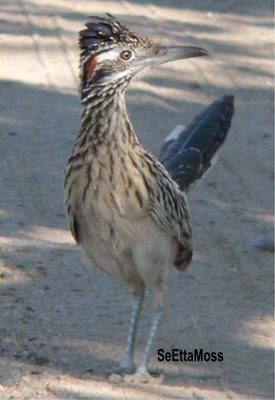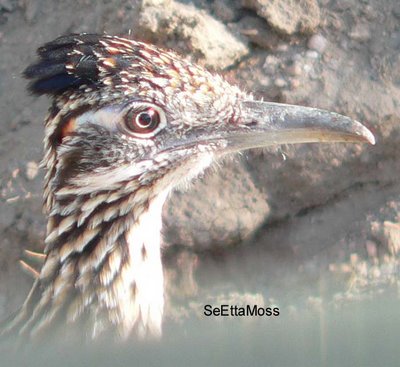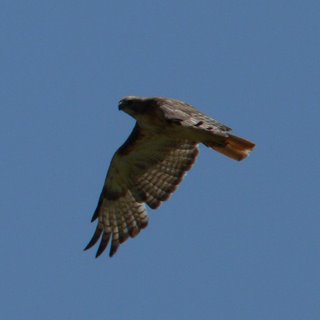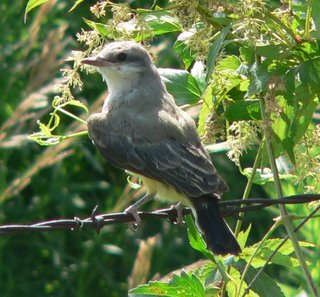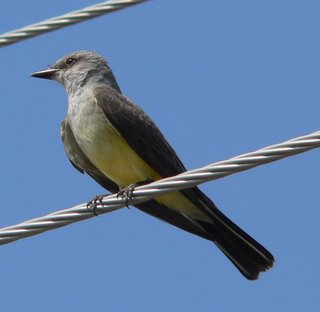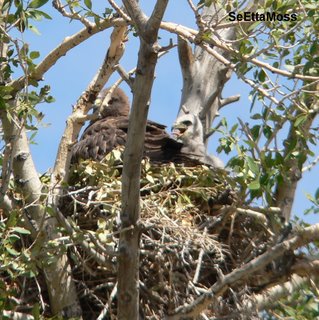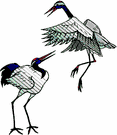Today I birded Cottonwood Canyon, a birding hotspot in far SE Colorado near the New Mexico border. Surrounded by sandsage and short-grass prairies, the canynonlands that exist in SE Colorado are surprising oases in a normally semi-arid environment as the bottom of these canyons are both perenneal streams and ephemeral water courses. Cottonwood Canyon is one of the most lush areas with many cottonwood trees mixing with pinyon, juniper and scrub-oak with a surprising amount of water in the stream in mid-summer in drought conditions. These conditions result in fantastic bird habitat.
Several southwestern species are found here and I saw several of them today. Ladderback Woodpecker is often seen here and today I saw 2. Another bird thought of as a southwestern specialty is the Greater Roadrunner--today I heard one calling and saw 2-3 more. One of them behaved curious towards me. When I first saw it the roadrunner was about 40 feet away. I stopped my car, and stepped just outside so I could take some photos. The bird came closer and closer. I remained standing next to my open car door the entire time. The bird approached within a few feet of my car. I got great photos but posting them will have to wait until I go home.
I saw 2 Yellow-billed Cuckoos, a species of special concern. When I saw the first one, it was flying in the sunlight bringing out the bright rufous primaries. I was confused by this as I almost always see these skulkers in heavily forested areas, and often surrouded by foliage, so I am not accustomed to the rufous color in their wings being so prominent.
Another species of special concern that I saw was Lewis's Woodpecker. I saw at least 2 family groups, each with 2 adults and 1 fledgling they were feeding. These birds make use of the cottonwood trees in this canyon. Then there was a mystery woodpecker type. It sounded like a Red-naped Sapsucker and looked a lot like one, but the photo on my camera LCD screen is confusing so will have to wait to upload the pic to see if I can confirm id.
There were at least 5 Mississippi Kites flying in the canyon and I stumbled upon a nest with 1 nestling in an area I was looking for other, much smaller, birds. I heard a kite calling and looked up to find the nest. After I took some pics I moved away to continue birding. As I was watching for another bird I saw one of the kites dive over nearby cliffs then do somersaults as it turned to fly into the cottonwood where the nest was located--this was a really astounding flight demonstration! Later an adult kite flew into a tree nearby. I could see that it had a large insect in it's beak, apparently food for the nestling. So I walked several hundred feet away so the bird would feel comfortable going to the nest.
Other birds in this canyon were Blue-gray Gnatcatchers, Downey Woodpeckers, a Belted Kingfisher, Lesser Goldfinch, singing House Wrens, singing Indigo Bunting, singing Blue Grosbeak, and singing Canyon Wrens. Several Turkey Vultures flew along the bluffs. A Wild Turkey hen foraged with her 3 offspring. And at dusk a few nighthawks came out to hunt insects.
Insects--the mosquitos were horrendous in some places. As much as I hate Deet, when the Picardin I put on didn't help I that stinky stuff--and even with Deet on I was being eaten up. On the positive side there were some great dragonflies there, including some really outstanding ones (again I got great pics but have to wait until I go home to upload and post).
On the way to and from Cottonwood Canyon I saw 3 Swainson's, 3 Ferruginous and 2 Red-tailed Hawks. There were several Burrowing Owls near a number of prairie dog colonies. A Great Blue Heron was in Carrizo Creek just before the canyon. There were lots of Horned Larks, Western Kingbirds and a few Cassin's Kingbirds too.
What a great day of fantastic birding.
SeEtta
